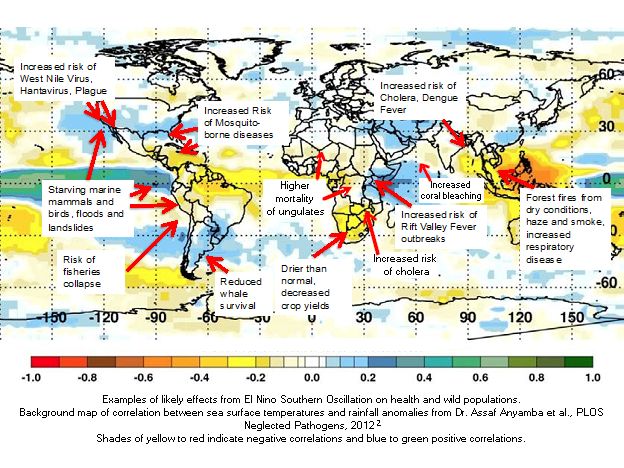Early warning and early action – the coming El Niño Southern Oscillation phenomenon and health impacts

17 July 2023
Statement of the WOAH Working Group on Wildlife
Climatic conditions associated with the El Niño Southern Oscillation [1] (ENSO) phenomenon have short-term extreme effects on weather patterns resulting in departures from normal rainfall, ocean and land temperature and ecological conditions globally. Analyses have shown that disease outbreaks follow these extreme shifts, illustrating that extreme ends of the moisture spectrum (both wetter and drier) provide favourable ecological conditions for arthropod vectors and human and animal pathogens to emerge and propagate clusters of diseases.
Historically when such extreme departures from climatic norms have occurred, host-pathogen imbalances have led to disease epidemics in both human and animal populations. Examples include Rift Valley fever, malaria, cholera, hantavirus disease, plague, and West Nile virus disease. Moreover, ENSO may be additive on to climate change effects and the combined outcomes are unclear yet potentially more significant.

Non-infectious diseases also result from these climatic changes as seen in fish stock collapse, harmful algal blooms and toxin accumulation in food chains, forest fires and air quality effects on respiratory disease, and changes in pasture and crop yields affecting food supply.
ENSO events present additional challenges for the One Health capacity of terrestrial and aquatic animal health and risk management authorities. Therefore, veterinarians and human health practitioners should work together to be prepared for the coming ENSO event that is now beginning. Anticipating and preparing for what we know are the regionally predictable effects of increased rainfall and droughts, and changes in temperature both on land and at sea can reduce health risks and protect lives and livelihoods. For instance, WOAH’s PROVNA project aims to help countries in North Africa target their surveillance on Rift Valley fever using remote sensing and earth observation data.
The World Organization for Animal Health and its Working Group on Wildlife is available to provide expertise and guidance through this event.
Founded in 1994, the Working Group on Wildlife informs and advises WOAH on all health problems relating to wild animals, whether in the wild or in captivity. It prepares recommendations and oversees numerous scientific publications on the surveillance and control of the most important specific wildlife diseases.
[1] The ENSO phenomenon refers to the variations in atmospheric and ocean conditions, or in the climate conditions, arising from variations in sea surface temperatures and atmospheric pressure across the tropical Pacific Ocean (McGregor, G.R.; Ebi, K. El Niño Southern Oscillation (ENSO) and Health: An Overview for Climate and Health Researchers. Atmosphere 2018, 9, 282. https://doi.org/10.3390/atmos9070282)
[2] Anyamba A, Linthicum KJ, Small JL, Collins KM, Tucker CJ, et al. (2012) Climate Teleconnections and Recent Patterns of Human and Animal Disease Outbreaks. PLoS Negl Trop Dis 6(1): e1465.doi:10.1371/journal.pntd.0001465 Also cited: Moore, Sean M., et al. “El Niño and the shifting geography of cholera in Africa.” Proceedings of the National Academy of Sciences 114.17 (2017): 4436-4441, Arthur, Rohan. “Coral bleaching and mortality in three Indian reef regions during an El Niño southern oscillation event.” Current Science (2000): 1723-1729, Ogutu, Joseph O., et al. “El Niño‐southern oscillation, rainfall, temperature and normalized difference vegetation index fluctuations in the Mara‐Serengeti ecosystem.” African Journal of Ecology 46.2 (2008): 132-143.
More information
-
Working Group on Wildlife: Members
-
WOAH Wildlife Health page
Contact
For any information, reach out to:
